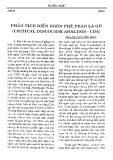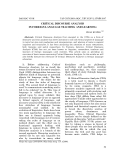
P-ISSN 1859-3585 E-ISSN 2615-9619 https://jst-haui.vn LANGUAGE - CULTURE
Vol. 61 - No. 2 (Feb 2025) HaUI Journal of Science and Technology
147
PRESUPPOSITIONS IN THE SPEECH BY THE U.S. SECRETARY
OF DEFENSE AT THE SHANGRI-LA DIALOGUE 2022:
A CRITICAL DISCOURSE ANALYSIS
TIỀN GIẢ ĐỊNH TRONG BÀI PHÁT BIỂU CỦA BỘ TRƯỞNG BỘ QUỐC PHÒNG MỸ
TẠI ĐỐI THOẠI SHANGRI-LA NĂM 2022: PHÂN TÍCH DIỄN NGÔN PHẢN BIỆN
Lanh Thuy Dzung1,*, Nguyen Thi Nguyet Minh1
DOI: http://doi.org/10.57001/huih5804.2025.048
1. INTRODUCTION
In the contemporary complex
geopolitical environment, political
discourse is regarded as a powerful tool
of ideology formation, policy
legitimation, and backing for power. The
Asia-Pacific area, where territorial claims,
military alliances, and competitive
strategies are ubiquitous, remains a
main platform for international
competition [1]. As tensions rise, world
powers, particularly the United States
and China, employ discursive strategies
to project power, delineate allies and
enemies, and legitimize their actions [2].
But beyond outright declaration,
political speeches tend to invest implicit
meaning through linguistic devices like
presuppositions, which frame things
subtly and, in turn, influence public
opinion [3].
A significant platform for such
discourse is the Shangri-La Dialogue,
an annual security forum where
defence leaders discuss regional and
global security concerns. The U.S.
Secretary of Defense’s speeches at this
forum not only outline military
strategies but also construct
ideological narratives. While much
attention is given to the explicit policy
ABSTRACT
This research analyzed the application of
presuppositions in disclosing the information in the
speech by the U.S. Secretary of Defense at the Shangri-
la Dialogue 2022 through the lenses of
Critical Discourse Analysis. With keen observation of the linguistic choices, the research analyzed
how presu
ppositions contribute to revealing the hidden meaning in constructing strategic
narratives. The findings revealed that presuppositions played a critical role in supporting ideological
positions, positioning the U.S. and its allies as champions of stability
, international law, and
cooperation, while groups against them are presented in a subtle manner as being against such
ideals. In this analysis, the research points out the role of presuppositions in language as a means
to limit perceptions and justify policy positions in international security discourse.
Keywords: U.S. Secretary of Defense, Shangri-
la Dialogue, Critical Discourse Analysis, Ideology,
International Relations, Presupposition,
TÓM TẮT
Nghiên cứu này phân tích vai trò của tiên giả định trong việc hình thành diễn ngôn của Bộ trưở
ng
Quốc phòng Hoa Kỳ tại Đối thoại Shangri-la 2022 dưới góc nhìn của Phân tích Diễn ngôn Phản biệ
n.
Thông qua việc phân tích cách sử dụng ngôn ngữ, nghiên cứu chỉ ra rằng những ý nghĩa tiềm ẩ
n trong
bài phát biểu có thể được nhận diện qua tiên giả định. Kết quả cho thấy tiên giả định đóng vai tr
ò quan
trọng trong việc củng cố lập trường ý thức hệ, khẳng định vị thế của Hoa Kỳ và các đồ
ng minh như
những bên thúc đẩy ổn định, luật pháp quốc tế và hợp tác, đồng thời ngầm mô tả các đối thủ như nhữ
ng
thách thức đối với các giá trị này. Nghiên cứu cũng làm nổi bật cách tiền giả định trong diễ
n ngôn có
thể định hướng nhận thức và hợp thức hóa lập trường chính sách trong bối cảnh an ninh quốc tế.
Từ khóa: Bộ trưởng Bộ Quốc phòng Mỹ, đối thoại Shangri-la, phân tích diễn ngôn phản biệ
n,
ý th
ức hệ, quan hệ quốc tế, tiền giả định.
1Military Science Academy, Vietnam
*Email: thuydzunglanh@gmail.com
Received: 18/01/2025
Revised: 20/02/2025
Accepted: 27/02/2025














